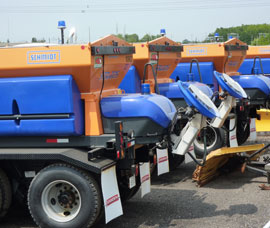 If you’ve ever had your municipal capital or operating budget for the year fall short, you know how many headaches it causes. Particularly in terms of your capital equipment budget, it can result in not having enough funds to replace or acquire the machines you truly need.
If you’ve ever had your municipal capital or operating budget for the year fall short, you know how many headaches it causes. Particularly in terms of your capital equipment budget, it can result in not having enough funds to replace or acquire the machines you truly need.
It’s much easier to advocate for more money before the fiscal year once budget has already been set.
In our experience, municipal equipment budgets are usually underestimated and easily remedied.
Below, we’ll highlight some tips so you can set accurate capital equipment replacement budgets going into next year:
Tip 1: Assume Next Year’s Heavy Equipment Costs Are Not the Same as this Year’s
It’s easy to assume current capital budget amounts should be adequate to accomplish your acquisition goals. But heavy equipment costs can vary greatly from year to year.
Factors such as manufacturer cost increases, new licensing requirements, dealer costs, and especially foreign exchange considerations can affect capital replacement budget numbers.
Your municipal equipment dealers are the best source for confirming budget numbers for replacement needs. Call or email them to confirm.
Solution: Treat each year as distinct; pay particular attention to the budgeted replacement cost for every line item. Get an accurate assessment of your current machines so you can make informed budgeting predictions into the future.
Tip 2: Determine Where Your Asset Is within Its Lifecycle to Understand Upkeep Costs
It’s a good idea to audit all of your heavy equipment before budget season comes around, so you’ll have an accurate picture of where they are in their lifecycle. Consider how they’ve performed, what it might take in terms of parts and labour to keep it operating well, and ultimately whether you’re likely to need a plan a capital budget replacement sooner rather than later.
Are the units going to be used in an appreciably different manner or time this year? This can affect wear items needed, and could increase or decrease your expected maintenance costs from the operating budget.
What will you need for replacement parts? All parts are not equal, and beyond that, all parts are not subjected to the same conditions. Many factors can impact how long any specific part will last, including wear resistance.
Typically, both OEM and will fit parts will work; however, they may have vastly different service lives.
It is not so important what the part costs, rather the cost per hour of service life! Buying a part that costs twice as much as competitor makes sense if it lasts 3 or 4 times longer.
Solution: Don’t guess! Have an expert inspect your parts and give you informed projections of how long they will last.
Bonus Tip – keep in mind foreign exchange changes when budgeting for new parts!
Tip 3: Assuming Similar Equipment Requires Similar Maintenance throughout Their Lifecycles
As equipment gets older, maintenance costs go up. But this doesn’t always happen in a uniform manner across your fleet of machines and even the same make of machines.
- What are the operating conditions of each machine?
Machines operating in urban settings could have different lifespans and operating costs than machines in suburban settings. The opposite could also be true with higher travel requirements versus short travel.
- Different operators can affect maintenance and uptime costs
Differences in operation may cause wear-and-tear on different parts in different ways. One operator may be harder on a machine than another, affecting the life of wear and component parts.
For all of these reasons, assuming how long any given part will last will always be closer to a guess than predictable. Again, for wear parts, a good measure is always a cost per hour of life – this way you can determine for the same part if any operational issues are affecting wear life, and thus costs.
On top of the variations due to conditions, operators, and use, it’s important to know that not all servicing is alike. Superior servicing will maximize your uptime, prevent issues, and improve the longevity of your machines. Unfortunately, poor servicing can do just the opposite, becoming quite costly in the long run.
Solution: Conduct an audit of your equipment with a focus on future maintenance costs. Ensure the servicing company you are working with is providing you with truly top-notch service.
Get Accurate Assessments and Estimates for Next Year’s Budget
The trick to ensuring better accuracy is easy – base next year’s heavy equipment budget on detailed assessments and informed estimates. Only a thorough audit of your machines and parts, as well as knowing your anticipated needs, will yield the accurate information you need to budget for next year with confidence.
Amaco’s factory-trained mechanics are experts in servicing. We offer complete heavy equipment audits for municipalities to help assess current and future costs. Contact us today!
- 5 Key Steps to Choosing the Right Curb Machine for Your Fleet - October 22, 2024
- 5 Tips for Purchasing Used Excavating Equipment in Ontario - September 26, 2024
- Pioneering Innovations in Concrete Paving With Power Curbers - September 4, 2024

